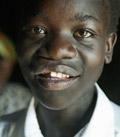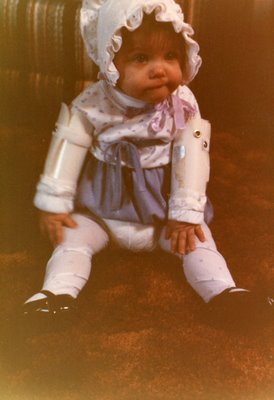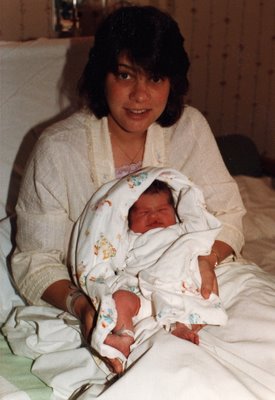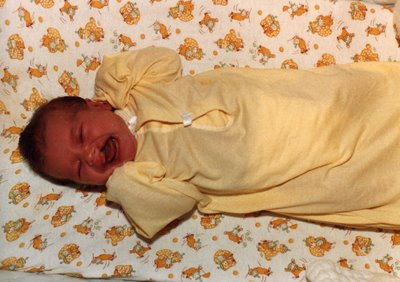Please keep Operation Smile and their mission in your prayers. Thank you.
Operation Smile
Thursday, May 25, 2006
Here is a final story from OS that I would like to leave you with...
Just five years old and already I know about rejection, denial and disappointment. It’s a hard lesson for a child like me whose only desire is to be normal. Through no fault of my own, I was born with a disfiguring cleft lip. Outside of our home, my mother says I would duck and cover my head since it hurt me so much to be stared at. I love to play baseball though, and it took a lot of courage for me to join the other village kids when they played because of how much they teased me.Every night before going to bed, I would get on my knees and pray for a miracle that would make me look just like all the other kids. My prayers were answered. During the Operation Smile medical mission to Barinas, Venezuela, I was one of more than 160 children selected for surgery. When my father saw me in the recovery room, he said, “I feel joy, much joy. I thank all the doctors. May they keep performing this good work, not only for my child, but for all the children who need it.”
www.operationsmile.com
Over the course of this semester I have learned so much about Cleft Lip and Palate. I thought I already knew everything I need to know but I found that that wasn't the case at all. I now realize the growing need of children who are less fortunate and need our help to answers their prayer.
If you ever need more information you can always go to
www.operationsmile.com

I was born with a cleft lip in Kaptrit, a small village in western Kenya. My parents didn’t know that the repair of my lip was possible, and many of the children in our village were afraid of me. When I was 13, my family learned from our neighbor, Joseph Zewedi, that Operation Smile doctors would be providing surgery in Nakuru. Unfortunately, my parents didn’t have enough money for the trip to the hospital. Kind-hearted Joseph started a collection in the village for the money — about $3.50 — for a one-way bus ticket to the mission site. Joseph raised the funds, and he and I began our eight-hour journey to Nakuru.
Three years later, my mother confessed that she never believed my lip would actually be repaired during the medical mission. She wanted the volunteers of Operation Smile to know that she is eternally grateful. So am I. Now, the children in my village not only accept me, they believe I hold some kind of magic. I have more friends than ever.
Here are some stories from the children. If you want to see more go to www.operationsmile.com
Just five years old and already I know about rejection, denial and disappointment. It’s a hard lesson for a child like me whose only desire is to be normal. Through no fault of my own, I was born with a disfiguring cleft lip. Outside of our home, my mother says I would duck and cover my head since it hurt me so much to be stared at. I love to play baseball though, and it took a lot of courage for me to join the other village kids when they played because of how much they teased me.
Every night before going to bed, I would get on my knees and pray for a miracle that would make me look just like all the other kids. My prayers were answered. During the Operation Smile medical mission to Barinas, Venezuela, I was one of more than 160 children selected for surgery. When my father saw me in the recovery room, he said, “I feel joy, much joy. I thank all the doctors. May they keep performing this good work, not only for my child, but for all the children who need it.”
Wednesday, May 24, 2006
Tuesday, May 23, 2006
Tuesday, May 09, 2006
Monday, May 08, 2006
Currently Operation Smile is in Ninh Thuan, Vietnam. They have fifty Operation Smile medical and non-medical volunteers in the city of Ninh Thuan. This is the first Operation Smile mission conducted in this city.
Sunday, May 07, 2006
Saturday, May 06, 2006
Here is some information from http://www.cleftline.org/publications/bonegraft.htm
Bone Grafting the Cleft Maxilla
Bone grafting in the dental ridge of the upper jaw (maxilla) is now standard, reliable treatment for patients with facial clefts. Bone grafting is an operation which involves taking a small amount of bone from one place (usually the hip, head, ribs, or leg) and placing it in the area of the cleft near the teeth. The procedure is employed to accomplish the following four goals:
To provide support for unerupted teeth and teeth next to the cleft.
To provide support for the lip and nose and to improve symmetry.
To form a continuous upper gum (alveolar) ridge, creating a more natural appearance and stability to the ridge.
To improve the stability of the front part of the roof of the mouth (premaxilla), if a bilateral cleft is present.
Bone grafting is a useful procedure and is most successful in patients under 10 years of age and as early as 5 to 6 years of age as the front incisor teeth are erupting. The overall erupting varies from child to child but usually is completed between the ages of 10 and 12. If the bone graft is placed after the permanent teeth have erupted, it will be too late to achieve goal number one above, although it may be useful toward achieving the remaining three goals.
Older patients may benefit from a bone graft but have less chance of total success. If the patient is a smoker, has a systemic disease such as diabetes, or has poor oral hygiene, the risk that the graft may fail increases even more.
Once the bone graft has been placed, there are three options that may be considered to replace any missing teeth in the area of the graft. These are: 1) moving adjacent teeth into the bone graft; 2) prosthetic replacement (dental bridge); or 3) dental metallic bone implants. The best option for an individual patient is best decided by the dental specialists on the cleft palate team.
Friday, May 05, 2006
Wednesday, May 03, 2006
Because I have been talking to much about the initial basic surgeries with Clefts I thought it might be a good idea to discuss some of the further surgeries that can be done. First, I will talk about bone grafts. I had a bone graft in the fourth grade. I don't remember it being too bad. The doctors took a bone from my hip and put it in my upper gum were my cleft was. I had my surgery at Children's Hospital in Minneapolis. I remember the staff being really friendly and made some friends my age. I will add some professional information on the blog as well.
Tuesday, May 02, 2006
Because this blog focuses so much on the facial deformations I thought I would put on here my favorite Psalm. I think it is just such a great reminder.
Psalm 139
1 O LORD, you have searched me
and you know me.
2 You know when I sit and when I rise;
you perceive my thoughts from afar.
3 You discern my going out and my lying down;
you are familiar with all my ways.
4 Before a word is on my tongue
you know it completely, O LORD.
5 You hem me in—behind and before;
you have laid your hand upon me.
6 Such knowledge is too wonderful for me,
too lofty for me to attain.
7 Where can I go from your Spirit?
Where can I flee from your presence?
8 If I go up to the heavens, you are there;
if I make my bed in the depths, [a] you are there.
9 If I rise on the wings of the dawn,
if I settle on the far side of the sea,
10 even there your hand will guide me,
your right hand will hold me fast.
11 If I say, "Surely the darkness will hide me
and the light become night around me,"
12 even the darkness will not be dark to you;
the night will shine like the day,
for darkness is as light to you.
13 For you created my inmost being;
you knit me together in my mother's womb.
14 I praise you because I am fearfully and wonderfully made;
your works are wonderful,
I know that full well.
15 My frame was not hidden from you
when I was made in the secret place.
When I was woven together in the depths of the earth,
16 your eyes saw my unformed body.
All the days ordained for me
were written in your book
before one of them came to be.
17 How precious to [b] me are your thoughts, O God!
How vast is the sum of them!
18 Were I to count them,
they would outnumber the grains of sand.
When I awake,
I am still with you.
19 If only you would slay the wicked, O God!
Away from me, you bloodthirsty men!
20 They speak of you with evil intent;
your adversaries misuse your name.
21 Do I not hate those who hate you, O LORD,
and abhor those who rise up against you?
22 I have nothing but hatred for them;
I count them my enemies.
23 Search me, O God, and know my heart;
test me and know my anxious thoughts.
24 See if there is any offensive way in me,
and lead me in the way everlasting.
Monday, May 01, 2006
Here is a story from one of the children that when through Operation Smile from the Operation Smile website...
http://www.operationsmile.org/testimonials/guillermo/
"One day when my mom was pregnant with me, she looked up into the darkening sky and realized there was a solar eclipse. Later, when I was born with a cleft lip and cleft palate, she and my dad said it was because of that eclipse. Luckily, they heard about an Operation Smile mission coming to Managua, near where we live. They saved and saved, mom working as a seamstress and dad as a construction worker, and were able to put enough money aside to pay for our transportation. Now, five months after I was born, my lip has been repaired.
My family says I smile a lot more now. I still have to have another surgery for the roof of my mouth, but I’m halfway there. My parents told the nice medical volunteers: “We are very thankful because these medical missions help poor people. The people here could not afford these surgeries, with how hard life is in Nicaragua. We cannot repay these people for what they did for our child and all the other children.”
Here is some information on surgery from the American Society of Plastic Surgeons....
http://www.plasticsurgery.org/public_education/procedures/CleftLipPalate.cfm
If you're considering surgery to correct cleft lip or palate...
In the early weeks of development, long before a child is born, the right and left sides of the lip and the roof of the mouth normally grow together. Occasionally, however, in about one of every 800 babies, those sections don't quite meet. A child born with a separation in the upper lip is said to have a cleft lip. A similar birth defect in the roof of the mouth, or palate, is called a cleft palate. Since the lip and the palate develop separately, it is possible for a child to have a cleft lip, a cleft palate, or variations of both.
If your child was born with either or both of these conditions, your doctor will probably recommend surgery to repair it. Medical professionals have made great advances in treating children with clefts and can do a lot to help your child lead a normal, healthy, happy life.
This information will give you a basic understanding of the operation -- when it can help, how it's performed, and what results you can expect. It can't answer all of your questions, since a lot depends on you individual circumstances. Please be sure to ask your surgeon if there is anything you don't understand about the procedure.
THE IMPORTANCE OF A TEAM APPROACH
Children born with a cleft lip or palate may need the skills of several medical professionals to correct the problems associated with the cleft. In addition to needing plastic surgery to repair the opening, these children may have problems with their feeding and their teeth, their hearing, their speech, and their psychological development as they grow up.
For that reason, parents should seek the help of a Cleft Lip and Palate Team as early as possible. Medical professionals with special experience in the problems of cleft lip and palate have formed such teams all over the country to help parents plan for their child's care from birth, or even before. Typically, a Cleft Team might include a plastic surgeon, a pediatrician, a dentist, a speech and language specialist, a social worker, a hearing specialist, an ear-nose-throat specialist, a psychologist, a nurse, and a genetic counselor.
Ask your doctor for a referral to a Cleft Team in your area. Or, for more information, contact The Cleft Palate Foundation, 104 S. Estes Drive Suite 204, Chapel Hill, NC, 27514, (telephone: 800-24CLEFT).
ALL SURGERY CARRIES SOME UNCERTAINTY AND RISK
When surgery is done by a qualified plastic surgeon with experience in repairing cleft lip or palate, the results can be quite positive. Nevertheless, as with any operation, there are risks associated with surgery and specific complications associated with this procedure.
In cleft lip surgery, the most common problem is asymmetry, when one side of the mouth and nose does not match the other side. The goal of cleft lip surgery is to close the separation in the first operation. Occasionally, a second operation may be needed.
In cleft palate surgery, the goal is to close the opening in the roof of the mouth so the child can eat and learn to speak properly. Occasionally, poor healing in the palate or poor speech may require a second operation.
PLANNING FOR SURGERY
At your initial consultation, your doctor will discuss the details of the procedure he or she will use, including where the surgery will be performed, the type of anesthesia to be used, possible risks and complications, recovery, costs, and the results you can expect. Your surgeon will also answer any questions you may have about feeding your baby, by breast or by bottle, both before and after the surgery.
In most cases, health insurance policies will cover most or all of the cost of cleft lip or cleft palate surgery. Check your policy to make sure your child is covered and to see if there are any limitations on what types of treatment are covered.
CLEFT LIP SURGERY
A cleft lip can range in severity from a slight notch in the red part of the upper lip to a complete separation of the lip extending into the nose. Clefts can occur on one or both sides of the upper lip. Surgery is generally done when the child is about 10 weeks old.
To repair a cleft lip, the surgeon will make an incision on either side of the cleft from the mouth into the nostril. He or she will then turn the dark pink outer portion of the cleft down and pull the muscle and the skin of the lip together to close the separation. Muscle function and the normal "cupid's bow" shape of the mouth are restored. The nostril deformity often associated with cleft lip may also be improved at the time of lip repair or in a later surgery.
RECOVERING FROM CLEFT LIP SURGERY
Your child may be restless for awhile after surgery, but your doctor can prescribe medication to relieve any discomfort. Elbow restraints may be necessary for a few weeks to prevent your baby from rubbing the stitched area.
If dressings have been used, they'll be removed within a day or two, and the stitches will either dissolve or be removed within five days. Your doctor will advise you on how to feed your child during the first few weeks after surgery.
It's normal for the surgical scar to appear to get bigger and redder for a few weeks after surgery. This will gradually fade, although the scar will never totally disappear. In many children, however, it's barely noticeable because of the shadows formed by the nose and upper lip.
CLEFT PALATE SURGERY
In some children, a cleft palate may involve only a tiny portion at the back of the roof of the mouth; for others, it can mean a complete separation that extends from front to back. Just as in cleft lip, cleft palate may appear on one or both sides of the upper mouth. However, repairing a cleft palate involves more extensive surgery and is usually done when the child is nine to 18 months old, so the baby is bigger and better able to tolerate surgery.
To repair a cleft palate, the surgeon will make an incision on both sides of the separation, moving tissue from each side of the cleft to the center or midline of the roof of the mouth. This rebuilds the palate, joining muscle together and providing enough length in the palate so the child can eat and learn to speak properly.
RECOVERING FROM CLEFT PALATE SURGERY
For a day or two, your child will probably feel some soreness and pain, which is easily controlled by medication. During this period, you child will not eat or drink as much as usual -- so an intravenous line will be used to maintain fluid levels. Elbow restraints may be used to prevent your baby from rubbing the repaired area. Your doctor will advise you on how to feed your child during the first few weeks after surgery. It's crucial that you follow your doctor's advice on feeding to allow the palate to heal properly.
THE REPAIRED LIP OR PALATE
Children with a cleft palate are particularly prone to ear infections because the cleft can interfere with the function of the middle ear. To permit proper drainage and air circulation, the ear-nose-and-throat surgeon on the Cleft Palate Team may recommend that a small plastic ventilation tube be inserted in the eardrum. This relatively minor operation may be done later or at the time of the cleft repair. In addition, surgery may be recommended by your plastic surgeon when your child is older to refine the shape and function of the lip, nose, gums, and palate.
You'll want to discuss further needs with the members of the Cleft Team seeing your child.
Perhaps most important, keep in mind that surgery to repair a cleft lip or palate is only the beginning of the process. Family support is critical for your child. Love and understanding will help him or her grow up with a sense of self-esteem that extends beyond the physical defect.






